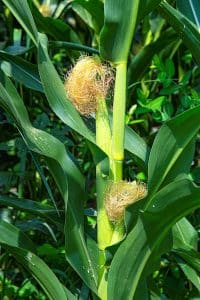So far, so good with this year’s corn

Corn is seen here adjacent to Route 3 southeast of Waterloo, maturing as tassels form on top of the plants and ears with silks form below.
It’s almost impossible to miss it even at highway speed as one drives through Monroe County, but the second crop of the summer’s big three is maturing.
The gold tassels appearing at the tops of each green cornstalk are the giveaways.
Those tassels are the male flower of the plant.
Easier to miss, because they are often hidden among the closely spaces stalks and green leaves, are the one or two corn ears.
They are the reason farmers willingly accept the costs of fertilizing soil and planting expensive seeds as the ground reaches the proper temperature and then hoping for a summer of proper rain and sun to promote best growth.
Technically, the corn plant is monoecious, which means each plant has male and female flowers. The corn plant’s tassel is the male flower and the ear is the female part of the plant.
At the top of each ear are a bundle of delicate gold threads called silks. Each kernel of corn forming inside the ear has its own silk attached to it. It is waiting to be dusted with pollen from the tassel at the top of the stalk.
The silks will last about 10 days. Any silk that is not dusted with pollen from above will fall off and there will be no kernel associated with it.
From this point, pollinated kernels will require 55 to 65 days to mature. This becomes the sole focus of the corn plant – to develop the pollinated kernels – even if that causes the plant itself to deteriorate.
The gamble farmers took to plant this year’s corn is not over yet. It will require adequate rain at proper intervals for the plants to mature and the kernels to form fully.
If there is not proper rain, we can see shriveling corn turn brown as it did several years ago, and the results may end as little more than feed for animals.
And of course, even if the crop is developing well, strong wind and storms can topple and destroy it.
The past weekend’s rain was just what was ordered for many Monroe County farmers, according to Gateway FS Grain Originator Phil Saale – although Bruce Brinkman of the Valmeyer-Harrisonville area reported some wind damage there.
But he graded the corn as well-pollinated and developing full ears – if the weather holds and adequate rain is received in coming weeks.
Some farmers saw less rain, and while that may not have damaged corn, more is needed, and some beans are needing to be replanted according to John Niebreugge, whose bottoms-area farm got less than an inch of rain.
Farmers will be monitoring the plants closely, waiting and hoping for the ears to develop fully, and the plants to remain standing tall until they dry and are ready to harvest.
That is the desired reward for the risks and hard work they commit to their crops.
Now that you know the details, watch over the next two months to see the results.






